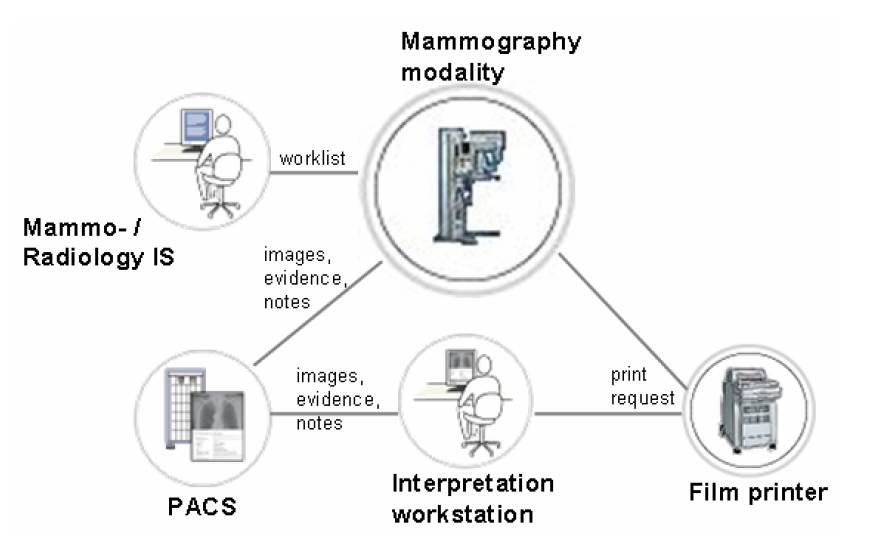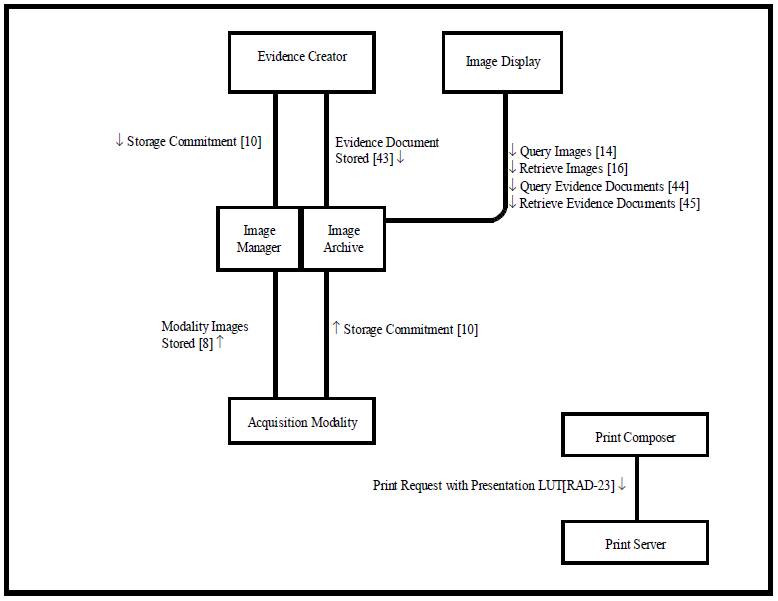Difference between revisions of "Mammography Image"
| (5 intermediate revisions by 2 users not shown) | |||
| Line 29: | Line 29: | ||
==Details== | ==Details== | ||
| + | The Mammography Image Profile specifies how DICOM Mammography images and evidence objects are created, exchanged and used. It describes how Acquisition Modalities transfer Full Field Digital Mammography (FFDM) Images, how CAD systems act as Evidence Creators, and how Image Displays should retrieve and make use of images and CAD results. It defines the basic display capabilities Image Displays are expected to provide, and which attributes should be used to implement those capabilities. | ||
| + | Managing the process of creating, storing and using Mammography Image content is similar to workflow for other image content (e.g., see Scheduled Workflow and Post-Processing Workflow Profiles). | ||
| + | |||
| + | The Mammography Image Profile is designed to provide faithful and complete storage and retrieval of Mammography data and sufficient display functionality to allow adequate review of current and prior images and CAD results for the purpose of primary interpretation by radiologists. It should also be sufficient for secondary review for referring physicians. It does not address the use of other modalities appropriate for breast imaging such as MR or US. | ||
==Systems Affected== | ==Systems Affected== | ||
| Line 49: | Line 53: | ||
'''Documents:''' | '''Documents:''' | ||
| − | :* [ | + | :* [https://www.ihe.net/resources/technical_frameworks/#radiology IHE Radiology Technical Framework] |
'''Underlying Standards:''' | '''Underlying Standards:''' | ||
| Line 82: | Line 86: | ||
'''Reference Articles''' | '''Reference Articles''' | ||
| − | * ''Storage, Transmission, and Retrieval of Digital Mammography, Including Recommendations on Image Compression'' | + | * ''Storage, Transmission, and Retrieval of Digital Mammography, Including Recommendations on Image Compression''; David Avrin, Richard Morin,David Piraino, Alan Rowberg, Nicholas Detorie, Margarita Zuley,J. Anthony Seibert, Etta D. Pisano; Journal of the American College of Radiology, Volume 3, Issue 8, August 2006, Pages 609–614 |
| − | * ''How to Transition to Digital Mammography'' | + | * ''How to Transition to Digital Mammography''; Margarita Zuley; Journal of the American College of Radiology, Volume 4, Issue 3, March 2007, Pages 178–183 |
| − | |||
| − | |||
| + | * ''IHE: What Is It and What Does It Have To Do with Mammography?''; Margarita Zuley; Seminars in Breast Disease: Radiologic, Pathologic and Surgical Considerations(2006) Volume 9 Issue 2 (Digital Mammography, Part I: Operational Considerations), Pages 82-84 | ||
This page is based on the [[Profile Overview Template]] | This page is based on the [[Profile Overview Template]] | ||
[[Category:Profiles]] | [[Category:Profiles]] | ||
| + | [[Category:RAD Profile]] | ||
| + | [[Category:DICOM]] | ||
Latest revision as of 18:47, 17 December 2020
The Mammography Image (MAMMO) Profile specifies how Mammography images and evidence objects are created, exchanged, used and displayed.
Summary
The IHE Mammography Image Profile ensures that the acquired digital mammography images contain all relevant information that is necessary for further image processing, application of CAD, storage, display, review and printing. This profile is absolutely necessary for generating correct digital mammography image content to ensure optimal presentation of images at a mammography review workstation.
Benefits
Support for the MAMMO profile will provide the following benefits to your healthcare enterprise:
- Reduce Errors and Enhance Patient Care
- Ensuring proper, consistent creation of patient and technical information
- Ensures that the acquired images contain the necessary data for identifying patient and technology, and that further image processing and review is correct and meaningful, mainly by:
- Scaling of the image so that images from the same patient, acquired on different detectors can be displayed at the same size or printed in true size
- Providing information to proper orientation and hanging of images
- Storing contrast information at the modality so that contrast adjustments do not degrade the quality of displayed images
- Clear definition of breast tissue and background air so that if contrast adjustments are made during interpretation of the images, the background blackness will be maintained for optimal viewing of the structure of the breast.
- Improve Image Quality
- Improves image display and printing by including relevant data in images
- Ensures that all technique acquisition parameters are available for review
- Ensures that the images can be oriented, justified and sized correctly for proper and expeditious interpretation
- Ensures that presentation images can be used in a consistent manner on different mammography review workstations
- Increase Throughput
- Reduces time to read the images. Images will be displayed on the screen oriented so that the important area is automatically displayed and with the correct orientation and sizing.
- Reduce costs by largely eliminating film printing, management and storage costs.
Details
The Mammography Image Profile specifies how DICOM Mammography images and evidence objects are created, exchanged and used. It describes how Acquisition Modalities transfer Full Field Digital Mammography (FFDM) Images, how CAD systems act as Evidence Creators, and how Image Displays should retrieve and make use of images and CAD results. It defines the basic display capabilities Image Displays are expected to provide, and which attributes should be used to implement those capabilities.
Managing the process of creating, storing and using Mammography Image content is similar to workflow for other image content (e.g., see Scheduled Workflow and Post-Processing Workflow Profiles).
The Mammography Image Profile is designed to provide faithful and complete storage and retrieval of Mammography data and sufficient display functionality to allow adequate review of current and prior images and CAD results for the purpose of primary interpretation by radiologists. It should also be sufficient for secondary review for referring physicians. It does not address the use of other modalities appropriate for breast imaging such as MR or US.
Systems Affected
- Modalities that create, store, and transmit Mammography images.
- PACS systems that store, manage, and/or display Mammography images.
- Display systems that query, retrieve and display Mammography images.
- Workstations that retrieve, process and display Mammography images, and may create evidence documents.
- Printers that print Mammography images in true size
Actors & Transactions:
Specification
Profile Status: Final Text
Documents:
Underlying Standards:
See Also
Related Profiles
- Scheduled Workflow [SWF] can manage the production of Digital Mammography Images.
- Mammography Acquisition Workflow [MAWF] is handling exceptions occurring during the acquisition workflow like changing the acquisition room, handling of recall scenarios or converting procedures
- Patient Information Reconciliation [PIR] is expected to reconcile Mammography Images along with the rest of the patient data record.
- Reporting Workflow [RWF] may use Mammography Images as inputs to the reporting process.
- Cross-enterprise Document Sharing for Imaging [XDS-I] can be used to share Mammography Images between sites over a network.
- Portable Data for Imaging [PDI] can store Mammography Images on media such as CDs.
- Import Reconciliation Workflow [IRWF] can fix patient ids, etc. of Mammography Images when importing.
Consumer Information
The IHE Radiology Mammography Users Handbook describes considerations when purchasing equipment to deploy this Profile.
Implementer Information
Reference Articles
- Storage, Transmission, and Retrieval of Digital Mammography, Including Recommendations on Image Compression; David Avrin, Richard Morin,David Piraino, Alan Rowberg, Nicholas Detorie, Margarita Zuley,J. Anthony Seibert, Etta D. Pisano; Journal of the American College of Radiology, Volume 3, Issue 8, August 2006, Pages 609–614
- How to Transition to Digital Mammography; Margarita Zuley; Journal of the American College of Radiology, Volume 4, Issue 3, March 2007, Pages 178–183
- IHE: What Is It and What Does It Have To Do with Mammography?; Margarita Zuley; Seminars in Breast Disease: Radiologic, Pathologic and Surgical Considerations(2006) Volume 9 Issue 2 (Digital Mammography, Part I: Operational Considerations), Pages 82-84
This page is based on the Profile Overview Template

